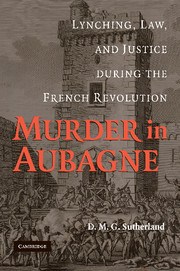Book contents
- Frontmatter
- Contents
- List of Figures
- Preface
- Acknowledgments
- Abbreviations
- Aubagne: An Introduction to the Problem
- 1 Structures and Events
- 2 The Olive Festival
- 3 Aubagne's Universe: Marseille, Aix, and Arles, 1789–1792
- 4 Murders in Provence
- 5 Vigilantism and Federalism
- 6 Federalism
- 7 Terror in a Small Town: Aubagne
- 8 The Revolution of the Antiterrorists: Vengeance, Massacre, and Justice
- 9 The Bande d'Aubagne
- Conclusion
- Appendix
- Sources and Methods
- Index
1 - Structures and Events
Published online by Cambridge University Press: 13 August 2009
- Frontmatter
- Contents
- List of Figures
- Preface
- Acknowledgments
- Abbreviations
- Aubagne: An Introduction to the Problem
- 1 Structures and Events
- 2 The Olive Festival
- 3 Aubagne's Universe: Marseille, Aix, and Arles, 1789–1792
- 4 Murders in Provence
- 5 Vigilantism and Federalism
- 6 Federalism
- 7 Terror in a Small Town: Aubagne
- 8 The Revolution of the Antiterrorists: Vengeance, Massacre, and Justice
- 9 The Bande d'Aubagne
- Conclusion
- Appendix
- Sources and Methods
- Index
Summary
It would be difficult to find a pays in France with more vulgar manners, more dissension, more hatred, [or] more jealousy. I will go further still and say, more bad faith, pride, [and] haughtiness without merit and without talent.… There are few towns in France as dirty as Aubagne.… Its inhabitants live in the cafés, tobacco shops, and gambling houses.
– Dr. Bernardin Ramel, a native of Aubagne, as cited in L. Barthélemy, Histoire d'Aubagne: Chef-lieu de baronnie, depuis son origine jusqu'en 1789On Sunday, 7 January 1787, around nine o'clock in the evening, a dozen or so men were celebrating King's Day. The group was formal, what contemporaries called a chambrée, a male association that met occasionally for drink and chat. The men had rented the meeting room overlooking the Grand' Rue in Aubagne. The celebration was important because there were guests present who were not normally invited. As the men danced and smoked around the fire, another group outside began pelting rocks through the windows. They broke a half dozen panes and the window frame itself. Then they ran off. A quarter of an hour later, they returned and began singing a well-known song but transformed the lyrics into “mocking and bloody threats.”
Nothing more came of the incident. Apparently, authorities or the plaintiffs decided not to pursue the assailants, who will always remain unknown. Still, this apparent case of minor vandalism and harassment has exceptional significance.
- Type
- Chapter
- Information
- Murder in AubagneLynching, Law, and Justice during the French Revolution, pp. 13 - 34Publisher: Cambridge University PressPrint publication year: 2009

